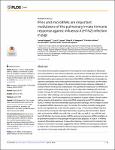IFN-λ and microRNAs are important modulators of the pulmonary innate immune response against influenza A (H1N2) infection in pigs
Brogaard, Louise
Larsen, Lars E.
Heegaard, Peter M. H.
Anthon, Christian
Gorodkin, Jan
Dürrwald, Ralf
Skovgaard, Kerstin
The innate immune system is paramount in the response to and clearance of influenza A virus (IAV) infection in non-immune individuals. Known factors include type I and III interferons and antiviral pathogen recognition receptors, and the cascades of antiviral and pro- and anti-inflammatory gene expression they induce. MicroRNAs (miRNAs) are increasingly recognized to participate in post-transcriptional modulation of these responses, but the temporal dynamics of how these players of the antiviral innate immune response collaborate to combat infection remain poorly characterized. We quantified the expression of miRNAs and protein coding genes in the lungs of pigs 1, 3, and 14 days after challenge with swine IAV (H1N2). Through RT-qPCR we observed a 400-fold relative increase in IFN-λ3 gene expression on day 1 after challenge, and a strong interferon-mediated antiviral response was observed on days 1 and 3 accompanied by up-regulation of genes related to the pro-inflammatory response and apoptosis. Using small RNA sequencing and qPCR validation we found 27 miRNAs that were differentially expressed after challenge, with the highest number of regulated miRNAs observed on day 3. In contrast, the number of protein coding genes found to be regulated due to IAV infection peaked on day 1. Pulmonary miRNAs may thus be aimed at fine-tuning the initial rapid inflammatory response after IAV infection. Specifically, we found five miRNAs (ssc-miR-15a, ssc-miR-18a, ssc-miR-21, ssc-miR-29b, and hsa-miR-590-3p)–four known porcine miRNAs and one novel porcine miRNA candidate–to be potential modulators of viral pathogen recognition and apoptosis. A total of 11 miRNAs remained differentially expressed 14 days after challenge, at which point the infection had cleared. In conclusion, the results suggested a role for miRNAs both during acute infection as well as later, with the potential to influence lung homeostasis and susceptibility to secondary infections in the lungs of pigs after IAV infection.
Dateien zu dieser Publikation

